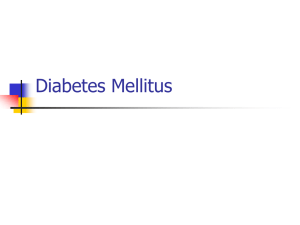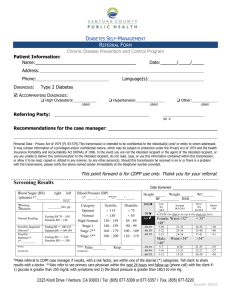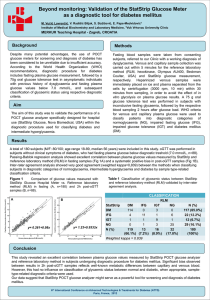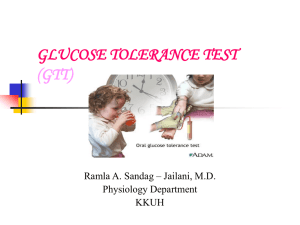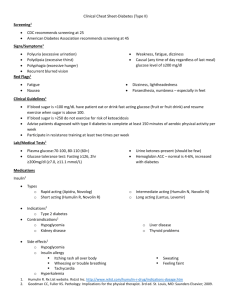Fasting Plasma Glucose - Blood Draw
advertisement
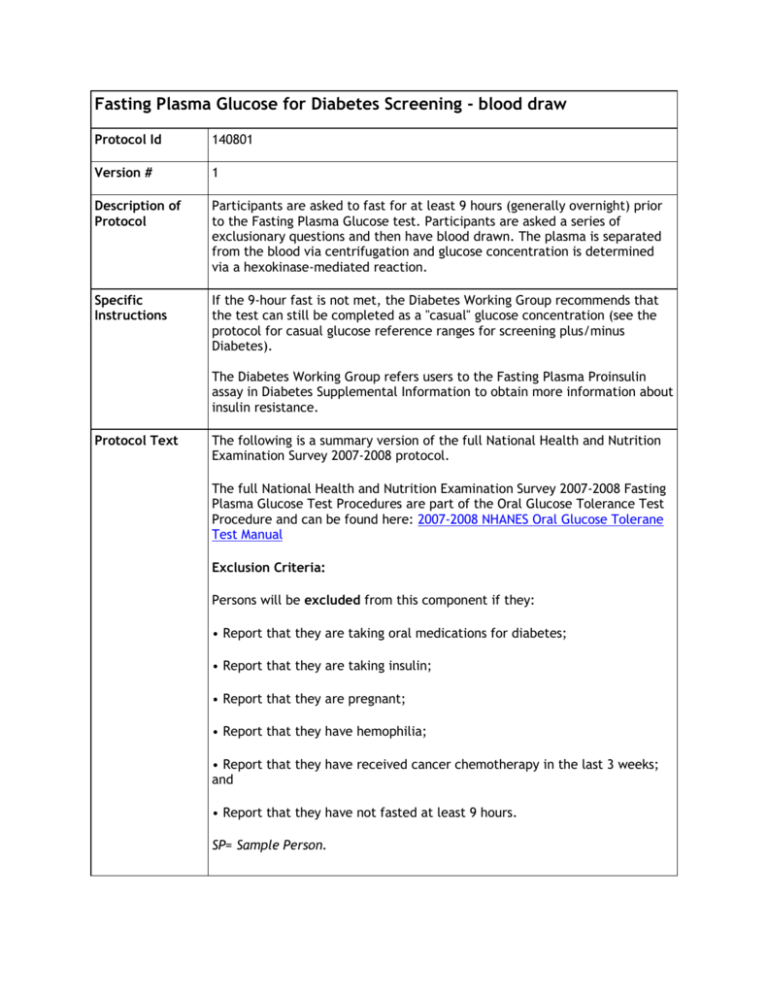
Fasting Plasma Glucose for Diabetes Screening - blood draw
Protocol Id
140801
Version #
1
Description of
Protocol
Participants are asked to fast for at least 9 hours (generally overnight) prior
to the Fasting Plasma Glucose test. Participants are asked a series of
exclusionary questions and then have blood drawn. The plasma is separated
from the blood via centrifugation and glucose concentration is determined
via a hexokinase-mediated reaction.
Specific
Instructions
If the 9-hour fast is not met, the Diabetes Working Group recommends that
the test can still be completed as a "casual" glucose concentration (see the
protocol for casual glucose reference ranges for screening plus/minus
Diabetes).
The Diabetes Working Group refers users to the Fasting Plasma Proinsulin
assay in Diabetes Supplemental Information to obtain more information about
insulin resistance.
Protocol Text
The following is a summary version of the full National Health and Nutrition
Examination Survey 2007-2008 protocol.
The full National Health and Nutrition Examination Survey 2007-2008 Fasting
Plasma Glucose Test Procedures are part of the Oral Glucose Tolerance Test
Procedure and can be found here: 2007-2008 NHANES Oral Glucose Tolerane
Test Manual
Exclusion Criteria:
Persons will be excluded from this component if they:
• Report that they are taking oral medications for diabetes;
• Report that they are taking insulin;
• Report that they are pregnant;
• Report that they have hemophilia;
• Report that they have received cancer chemotherapy in the last 3 weeks;
and
• Report that they have not fasted at least 9 hours.
SP= Sample Person.
1. Did you eat or drink anything other than plain water after [Insert time at 9
hours prior to sample collection] last night?
[ ] Yes
[ ] No
[ ] Refused
[ ] Don’t Know
If answer is "No" then he or she has met the 9-hour fast.
If answer is "Yes", "Don’t know", or "Refused", then the actual fasting time is
unknown.
Confirmation Question:
2. Have you had any of the following since {insert time from 1 here}?
Coffee or tea with cream and sugar? [Include milk or non-dairy creamers.]
[ ] Yes If Yes, record time and date_____________
[ ] No
Alcohol, such as beer, wine, or liquor?
[ ] Yes If Yes, record time and date_____________
[ ] No
Gum, breath mints, lozenges, or cough drops, or other cough or cold
remedies?
[ ] Yes If Yes, record time and date_____________
[ ] No
Antacids, laxatives, or anti-diarrheals?
[ ] Yes If Yes, record time and date_____________
[ ] No
Dietary Supplements such as vitamins and minerals? [Include multivitamins
and single nutrient supplements.]
[ ] Yes If Yes, record time and date_____________
[ ] No
Note from the Diabetes Working Group: Rather than asking if the subject
had anything to eat or drink after 11:30, the Working Group notes that is
acceptable to record the current time and time when the subject last had
anything other than plain water.
3. Are you currently pregnant?
1
[]
Yes
2
[]
No
3
[]
Don’t Know
If answer is "Yes", then the SP is blocked from the Fasting Plasma Glucose
test.
If answer is "No" or "Don’t Know," the SP completes Fasting Plasma Glucose
test.
4. {Is SP/Are you} now taking insulin?
1
[]
Yes
2
[]
No
7
[]
Refused
9
[]
Don’t Know
If the SP answers, "Yes," the SP is excluded from the Fasting Plasma Glucose
test.
If answer is "No" or "Don’t Know," the SP completes Fasting Plasma Glucose
test.
5. {Is SP/Are you} now taking diabetic pills to lower {his/her}/your} blood
sugar? These are sometimes called oral agents or oral hypoglycemic agents
1
[]
Yes
2
[]
No
7
[]
Refused
9
[]
Don’t Know
If the SP answers, "Yes," the SP is excluded from the Fasting Plasma Glucose
test.
If SP answer "No" or "Don’t Know," the SP completes Fasting Plasma Glucose
test.
6. Do you have hemophilia? (exclusion from Phlebotomy)
1
[]
Yes
2
[]
No
7
[]
Refused
9
[]
Don’t Know
If the SP answers, "Yes," the SP is excluded from the Fasting Plasma Glucose
test.
If SP answer "No" or "Don’t Know," the SP completes Fasting Plasma Glucose
test.
7. Have you received cancer chemotherapy in the past four weeks or do you
anticipate such therapy in the next four weeks? (exclusion from Phlebotomy)
1
[]
Yes
2
[]
No
7
[]
Refused
9
[]
Don’t Know
If the SP answers, "Yes," the SP is excluded from the Fasting Plasma Glucose
test.
If SP answer "No" or "Don’t Know," the SP completes Fasting Plasma Glucose
test.
Note from the Diabetes Working Group: The investigator should record the
reason(s) a sample person is excluded from the Fasting Plasma Glucose test.
Venipuncture
Note from the Diabetes Working Group: Blood should be collected in an
appropriate 10-mL EDTA tube. Invert the tube 3 to 4 times to mix, store on
ice and centrifuge within 30 minutes. Processing should yield ~ 4.5 mL of
plasma which can then be separated into several 0.5 mL aliquots for
multiple different tests.
Venipuncture should generally be performed using the median cubital,
cephalic, or basilic veins in the left arm unless this arm is unsuitable. If the
veins in the left arm are unsuitable, look for suitable veins on the right arm.
If the veins in the antecubital space on both arms are not suitable, then look
for veins in the forearm or dorsal side of the hand on the left arm/hand and
then the right arm/hand.
Editor’s Note: Please review chapter 4 of the Laboratory Procedures Manual
from the National Health and Nutrition Examination Survey 2007-2008 for a
full description of Phlebotomy procedures: 2007-2008 NHANES Lab Manual.
Recording the Results of the Venipuncture Procedure
Immediately after completing the venipuncture, record the results of the
blood draw, the reasons for a tube not being drawn according to the
protocol, and any comments about the venipuncture.
Note from the Diabetes Working Group: The Diabetes Working Group
recommends that the investigator record whether the blood was drawn and
whether the full amount was obtained.
Process the Sample for the Fasting Plasma Glucose Test
Editor’s Note: Please review chapter 8 of the Laboratory Procedures Manual
from the National Health and Nutrition Examination Survey 2007-2008 for a
full description of Blood Processing procedures: 2007-2008 NHANES Lab
Manual.
Centrifuge and separate the plasma from the 10-mL tube as soon as possible.
Process the specimen even if the contents of the gray tube clot.
• Separate the plasma by centrifugation.
• Use a calibrated plastic transfer pipette to transfer at least 0.5 mL plasma.
• Determine if the plasma is hemolyzed, turbid, lipemic, or icteric. If so,
enter a comment to describe the plasma.
• Close all vessels secured to prevent leakage and evaporation.
Note from the Diabetes Working Group: Plasma should be stored at -80°C
until testing and shipped on dry ice to prevent thawing.
Lab Assay for Fasting Plasma Glucose
The Diabetes Working Group recommends that glucose concentration be
determined according to a hexokinase-mediated reaction such as the one
developed by the University of Minnesota for use in the National Health and
Nutrition Examination Survey: 2007-2008 NHANES Fasting Glucose Lab Assay.
Note from the Diabetes Working Group: To aid comparability, the Diabetes
Working Group recommends that the investigator record the make and
manufacturer of equipment used and the repeatability and coefficients of
variation for the assay.
Reference Ranges:
Fasting plasma glucose concentration normally ranges between 60-100
mg/dL
Non-fasting glucose concentration normally ranges between 60-139 mg/dL
Selection
Rationale
The National Health and Nutrition Examination Survey 2007-2008 protocol
was selected as the best practice methodology and most widely used
protocol to measure Fasting Plasma Glucose concentration.
Source
Centers for Disease Control and Prevention (CDC). National Center for Health
Statistics (NCHS). National Health and Nutrition Examination Survey
Questionnaire. Oral Glucose Tolerance Test (OGTT) Procedures Manual.
Hyattsville, MD: U.S. Department of Health and Human Services, Centers for
Disease Control and Prevention, 2005-2006
Centers for Disease Control and Prevention (CDC). National Center for Health
Statistics (NCHS). National Health and Nutrition Examination Survey
Questionnaire. Laboratory Procedures Manual. Hyattsville, MD: U.S.
Department of Health and Human Services, Centers for Disease Control and
Prevention, 2007-2008
Centers for Disease Control and Prevention (CDC). National Center for Health
Statistics (NCHS). National Health and Nutrition Examination Survey
Questionnaire. Shared Exclusion Questions for the MEC Examination.
Hyattsville, MD: U.S. Department of Health and Human Services, Centers for
Disease Control and Prevention, 2002. (questions 6 and 7)
Language
English, Spanish
Participant
Participant aged 12 years and older
Personnel and
Training
Required
Phlebotomist
Medical Technologist
Laboratory which can perform hexokinase-mediated reaction
Equipment Needs Phlebotomy supplies
Standards
General
References
Standard
Name
ID
Source
Common Data Elements
(CDE)
Person Fasting Plasma
3070691 CDE Browser
Glucose Assay Concentration
Value
Logical Observation
Identifiers Names and
Codes (LOINC)
Fast plasma gluc blood draw
proto
62851-1 LOINC
American Diabetes Association. (2009). Diagnosis and classification of
diabetes mellitus. Diabetes Care, 32(Supplement 1), S62 - S67.
American Diabetes Association. (2008). Standards of medical care in diabetes
- 2008. Diabetes Care, 31(Supplement 1), S12 - S54.
Protocol Type
Bioassay
Derived Variables The threshold fasting plasma glucose concentrations for the scoring (+/-) of
prediabetes and diabetes are updated yearly by the American Diabetes
Association and can be found in the journal Diabetes Care.
Prediabetes
Fasting plasma glucose concentration between 100-125 mg/dl (5.6 - 6.9
mmol/l)
Diabetes
Fasting plasma glucose concentration greater than or equal to 126 mg/dl (7.0
mmol/l)
Casual glucose concentration greater than or equal to 200 mg/dl (11.1
mmol/l)
American Diabetes Association. (2010). Diagnosis and classification of
diabetes mellitus. Diabetes Care, 33 (Supplement 1), S11 - S61.
Requirements
Requirement Category
Required
Average time of greater than 15 minutes in an unaffected individual
Yes
Average time of greater than 15 minutes in an unaffected
individual
Major equipment
This measure requires a specialized measurement device that
may not be readily available in every setting where genome wide
No
association studies are being conducted. Examples of specialized
equipment are DEXA, Echocardiography, and Spirometry
Specialized requirements for biospecimen collection
No
This protocol requires that blood, urine, etc. be collected from
the study participants.
Specialized training
This measure requires staff training in the protocol methodology
and/or in the conduct of the data analysis.
No

